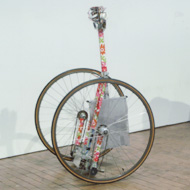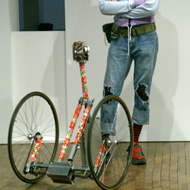| |
|||
 |
|||
| |
|||
| |
|||
|
|
|||
| |
|||
|
|
|||
| |
|||
| |
|||

SIMON PENNY – PETIT MAL Interactive robot, 1989-2005 The goal of Petit Mal was to produce a robotic artwork which was truly autonomous; which was nimble and had ‘charm'; that sensed and explored architectural space and that pursued and reacted to people; that gave the impression of intelligence and had behavior which was neither anthropomorphic nor zoomorphic, but which was unique to its physical and electronic nature. Petit Mal is an attempt to explore the aesthetics of machine behavior and embodied interaction in a real world setting. The aesthetic realm which Petit Mal inhabits is that of embodied gesture and spatial dynamics, a mode of interaction which takes place in the spatio-temporal realm of the body, in which kinesthetic intelligences, rather than ‘literary-imagistic' intelligences play a major role. The playfulness of Petit Mal is emblematic of its status as a critical intervention into robotics and artificial intelligence. Most conventional robots are elaborations of von Neumanns' notion of the universal machine, in which the physical machine is simply a formless form to be filled with software ‘content', an idea whose Cartesianism is self-evident. Contrarily, in Petit Mal, hardware and software were considered as a seamless continuity: its behavior cannot be separated from the dynamics of its ‘body'. The aim was to under-engineer as far as possible; to choose simple solutions over complex, even if they were statistically less reliable; to produce a robot which has seemingly intelligent relation to both objects and people, with the minimum of hardware, sensors and code. The design process of Petit Mal sought not to ‘design out' unreliable behavior, but to capitalize on mechanical or electronic quirks, such as the dynamics of the double pendulum structure or the limitations of a sensor, as generators of emergent behavior, of ‘personality'. Text: Simon Penny, photo: Jonathan Gröger |
